Petrol & Powder
Well-Known Member
The topic of the use of wadcutters and speedloaders came up in another thread. Rather than wildly drift that thread, I thought I would delve into that issue here.
First, allow me to address the elephant in the room. The potential of needing to reload in a self-defense scenario is mighty thin. This is more about speedloaders in general than a specific situation. Despite my extensive training and experience with speedloaders, I still prefer a speed strip for a concealed carry reload. They are flatter and far easier to carry and conceal than a speedloader.
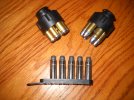
Bullet profile plays a role in the performance of a speedloader. A round nose, or truncated cone bullet will certainly “feed” more smoothly from a speedloader than any bullet with an exposed driving band. However, not all bullets are equally speedloader friendly. Wadcutters and semi-wadcutters have a sharp ledge created by that forward driving band that is outside the casing. It is that “ledge” that creates the difficulties when using a speedloader with that bullet profile.
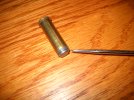
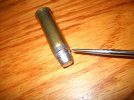
The SWC at least has a smaller nose that helps to guide the cartridges into the individual chambers (charge holes in S&W speak). The full wadcutter can be a bit fussier. There are some designs, such as the double ended SAECO #348, that are far more speedloader friendly.
So, bullet choice plays a role but there’s also the revolver cylinder itself that can affect the process. Adding a slight chamfer to the rear face of the cylinder at each chamber can noticeably improve the speedloader/gun interface. You don’t need, or want, to remove a lot of material. You just need to slightly break that sharp outer edge of the chamber. This modification was well known back in the days of matches involving duty revolvers and speedloaders.
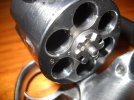 Note slight chamfer on outer edge of chamber mouth
Note slight chamfer on outer edge of chamber mouth
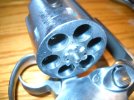 Unmodified cylinder with sharp rear edge at chamber mouth
Unmodified cylinder with sharp rear edge at chamber mouth
There are different methods to achieve this slight chamfer, but the emphasis is on the word slight. You do not want to get carried away here.
One method is to use a 45-degree cutter with a pilot to center it in the chamber. The cut that is made is very slight.
Another method is to use a ball cutter to just barely break the sharp edge of the chamber mouth.
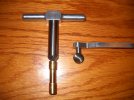
On a gun used exclusively for target shooting, the extractor can be left in place when using the ball cutter method.
When modifying a gun used for self-defense, the extractor is first removed before using either the 45-degree cutter or the ball cutter so that the extractor engagement with the cartridge rim is not compromised. After the chamfers are added to the chambers, the rear “points” of the extractor star are slightly rounded with a file to blend the extractor tips to the chamfers. In this process only the outer edges of the chambers are chamfered. (or "beveled" if you will)
The modified cylinder is far more speedloader friendly, even when using wadcutters.
First, allow me to address the elephant in the room. The potential of needing to reload in a self-defense scenario is mighty thin. This is more about speedloaders in general than a specific situation. Despite my extensive training and experience with speedloaders, I still prefer a speed strip for a concealed carry reload. They are flatter and far easier to carry and conceal than a speedloader.

Bullet profile plays a role in the performance of a speedloader. A round nose, or truncated cone bullet will certainly “feed” more smoothly from a speedloader than any bullet with an exposed driving band. However, not all bullets are equally speedloader friendly. Wadcutters and semi-wadcutters have a sharp ledge created by that forward driving band that is outside the casing. It is that “ledge” that creates the difficulties when using a speedloader with that bullet profile.


The SWC at least has a smaller nose that helps to guide the cartridges into the individual chambers (charge holes in S&W speak). The full wadcutter can be a bit fussier. There are some designs, such as the double ended SAECO #348, that are far more speedloader friendly.
So, bullet choice plays a role but there’s also the revolver cylinder itself that can affect the process. Adding a slight chamfer to the rear face of the cylinder at each chamber can noticeably improve the speedloader/gun interface. You don’t need, or want, to remove a lot of material. You just need to slightly break that sharp outer edge of the chamber. This modification was well known back in the days of matches involving duty revolvers and speedloaders.
 Note slight chamfer on outer edge of chamber mouth
Note slight chamfer on outer edge of chamber mouth Unmodified cylinder with sharp rear edge at chamber mouth
Unmodified cylinder with sharp rear edge at chamber mouthThere are different methods to achieve this slight chamfer, but the emphasis is on the word slight. You do not want to get carried away here.
One method is to use a 45-degree cutter with a pilot to center it in the chamber. The cut that is made is very slight.
Another method is to use a ball cutter to just barely break the sharp edge of the chamber mouth.

On a gun used exclusively for target shooting, the extractor can be left in place when using the ball cutter method.
When modifying a gun used for self-defense, the extractor is first removed before using either the 45-degree cutter or the ball cutter so that the extractor engagement with the cartridge rim is not compromised. After the chamfers are added to the chambers, the rear “points” of the extractor star are slightly rounded with a file to blend the extractor tips to the chamfers. In this process only the outer edges of the chambers are chamfered. (or "beveled" if you will)
The modified cylinder is far more speedloader friendly, even when using wadcutters.
Last edited:


